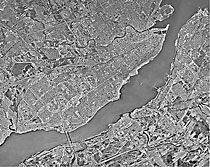Proactive disclosure
Print version   |  | 
Natural Resources Canada > Earth Sciences Sector > Priorities > Geoscape Canada > Québec
Geoscape Québec A Vital Corridor
The position of the St. Lawrence valley is dictated by the location of an ancient system of normal faults. The St. Lawrence rift system formed some 600 million years ago, in the Precambrian, during the break-up of a supercontinent that led to the formation of the Iapetus Ocean, the forerunner of the present-day Atlantic.
| The story of an ephemeral sea |
The current location of the river is an artefact of the most recent period of glaciation. After the ice melted, the postglacial Champlain Sea occupied the St. Lawrence valley for thousands of years. As the sea receded, the river bed was gradually established in the glacial materials left behind. About 9500 years ago, the Québec promontory was an island surrounded by two channels. The north channel, now the site of Québec's Lower Town, gradually dried up as the land rebounded. Today, the river and the tidal stream flow entirely along the ancient south channel.

Released from the burden of the glacier but still isostatically depressed as a result of its weight, the Québec region is flooded by the Champlain Sea to an elevation of 230 m. |

Québec gradually rebounds, and the Champlain Sea recedes. The first two high points on île d'Orléans emerge at an elevation of about 120 m. |

As the area continues to rebound, the sea becomes a river. At an elevation of about 60 m, numerous channels develop around the higher points of land. |

The course followed by the present-day St. Lawrence River is the product of a long history of tectonic, glacial, and marine events. |

A layover on the flats
|
Many of the flats that border the St. Lawrence estuary, such as those at Cap-Tourmente and Montmagny, are made up of vast accumulations of muddy sediment left behind after the retreat of the postglacial sea. These tidal mudflats are an ideal environment for the growth of bulrushes, a plant whose roots are an essential part of the diet of migrating snow geese.

The narrowing of the river inspired the Amerindian name for the city, 'Québec', wich became a part of history and means 'where the river narrows.
|
In 1608, when Champlain decided to establish a colony at the site of present-day Québec, it was because of the many advantages afforded by the geography of the location. From a strategic point of view, the Québec promontory offered an excellent natural defence. Because of the narrowness of the river, the passage of every ship could be monitored from the shore.
From an economic point of view, the river was also a natural gateway to the interior of the continent, guaranteeing access to the fur trade. Because of its location between the estuary and the river, Québec has long been a transshipment point from marine transportation to rail and river systems, a factor which has contributed greatly to its growth and to its development as a major seaport.
|
